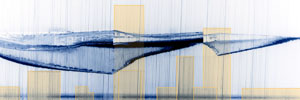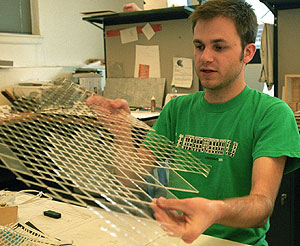“Architecture,” Goethe famously observed, “is frozen music.”
Yet for many contemporary architects, increasing sensitivity to natural phenomena such as light and shadow — as well as the development of technologically advanced materials such as motion sensors and solar panels — is transforming Goethe’s equation.

The music, so to speak, is beginning to flow free. Tyler Survant, who will receive an undergraduate degree from the Sam Fox School of Design & Visual Arts’ College of Architecture today, has spent much of the last year contemplating such matters.
Along with classmates Stephanie Beamer, Crystal Ellis and Hillary Petrie, Survant recently entered “Light of Tomorrow,” a conceptual design competition sponsored by VELUX, the European skylight manufacturer.
“In some ways, natural light goes almost unnoticed in the city,” Survant points out. “It’s never really captured or framed. The only times we’re typically aware of natural light are sunrise and sunset.”
The group’s submission, titled “Urban Cloud,” proposes a supple, semitransparent mesh designed to reflect, record and respond to subtle movements of the sun, clouds and sky. Inspired by the elastic, web-like geometry of fishnet stockings, the basic structure is adaptable to a variety of shapes and dimensions, from human-scale to the size of city blocks.

(Prizes and awards for the competition, totaling 30,000 euros (about $38,500), will be announced Oct. 23 during a ceremony at the Guggenheim Museum in Bilbao, Spain.)
“The grids are designed to be flexible,” Survant explains. “They can be stretched or compressed, causing the grain to shift, or they can curl back over one another to layer space. Depending on climatic conditions and the angle of the sun, you get different effects, different shadows, different qualities of light.
“Those ethereal qualities are hard to translate into real form,” he adds, noting that the VELUX competition is, after all, dedicated to theoretical design, not practical application.
“That’s the challenge of this kind of project. It’s the difference between a poem and an essay. An essay explains; a poem remains evocative.”
Survant is keenly attuned to the similarities and shared concerns — structure, proportion, harmony — that link architecture and music.
|
Sam Fox Schoolof Design & Visual Arts, College of Architecture |
Growing up in Lexington, Ky., he was an accomplished trumpet player, and in high school he performed with a variety of ensembles, winning the Lexington Philharmonic Band Award, the John Phillip Sousa Award and the Governor’s Scholar Scholarship.
At the University, Survant served as a Student Union senator for Architecture and as secretary and vice president for the Architecture Student Council. He worked as an art handler for the Sam Fox School’s Mildred Lane Kemper Art Museum.
He also spent three semesters as a teaching assistant for the sophomore studio “Intro to Design Processes,” working with Heather Woofter, assistant professor of architecture, and Pia Sarpaneva, visiting associate professor of architecture.
“Tyler is an amazing student,” says Woofter, who also served as faculty adviser for the VELUX entry. “He’s very articulate graphically and his work is very thoughtful. Yet he also has the capacity to work with different viewpoints, to find the connections between them and to make those connections his own. That synthesis is remarkable.”
Survant himself muses, “Representation goes beyond just conveying ideas to someone else. Representation helps you to understand the idea itself. It’s about learning through making — about building a visual language that allows you to discover new concepts and new ways of seeing.”
After graduation, Survant plans to remain in St. Louis for at least a year before enrolling in graduate school. He’d also like to continue developing projects and ideas with his VELUX collaborators, with an eye toward entering more conceptual competitions.
“This is kind of a transitional time,” he says. “I would love to design buildings, but I also don’t want to be limited to one path. I’m interested in teaching, in furniture designs, in architectural writing, in conceptual design.
“I’m beginning to think less about particular mediums and more about the ideas,” Survant concludes. “It’s about having a question that you address in your work.”